 Anyone familiar with that strip of Ossington Ave running north from Queen Street up to Dundas knows there's been quite a bit of change there in the last few years. The number of bars, restaurants, shops, and galleries that've sprung up is impressive. I live in the surrounding area myself and can attest to the difference a few short years makes. In terms of real estate values alone, the area has certainly experienced an increase. I helped some clients purchase a townhouse on Halton St, just east of Ossington, and the prices there have certainly benefited from what's happening in the area.
Anyone familiar with that strip of Ossington Ave running north from Queen Street up to Dundas knows there's been quite a bit of change there in the last few years. The number of bars, restaurants, shops, and galleries that've sprung up is impressive. I live in the surrounding area myself and can attest to the difference a few short years makes. In terms of real estate values alone, the area has certainly experienced an increase. I helped some clients purchase a townhouse on Halton St, just east of Ossington, and the prices there have certainly benefited from what's happening in the area.
So much change though, so quickly, isn't going to sit well with everyone. A number of residents in the immediate area voiced their concern about the increased nightlife and the city responded by placing a moratorium on new bars.
Personally, I'm somewhat divided on the moratorium. I'm happy for anything it's done to curb the over-saturation of clubs that some feel was on the horizon. But I'm also disappointed that a less restrictive solution wasn't adopted - a solution that would've allowed for more bakeries, daytime restaurants, etc, to find their way onto the strip.
This isn't to say that there hasn't been any growth along the strip since the moratorium went into effect last year. In fact, galleries and art spaces have really flourished. There was an article in yesterday's Toronto Star touching on this very subject. Take a look:
Following is Sarah Barmak's article from the March 14th Toronto Star in full:
One year after a controversial moratorium on new bars on the street was passed, much on Ossington Ave. has seemed frozen in time, with no new eateries and few new shops.
Other than the growth in gallery space, that is. More than ever, the Ossington art hub is alive and vibrant.
Jamie Angell's Angell Gallery relocated to the foot of Ossington from 890 Queen St. W., moving from 700 square feet to a cavernous 4,000. With its grand central space and satellite wings, it isn't hard to imagine Angell as a bustling bistro. Instead, it's now one of the bright lights of a booming creative nexus.
Further north on the strip, Meta Gallery is busily renovating their new space – formerly the eclectic art, market, concert, and event venue Rolly's Garage – for their grand opening on April 2.
The most impressive newcomer to the neighbourhood, the Artscape Shaw Street Centre, will add a mind-blowing 75,000 square feet of dedicated gallery and working space for artists to the area when it opens in 2012. A repurposing of the beautiful century-old Shaw Street School, which had been shuttered for a decade before Artscape bought it in January, the centre will be the largest project to date for the not-for-profit urban development organization behind the Wychwood Barns art community in the St. Clair and Christie neighbourhood.
Artscape's request for expressions of interest from artists – due Thursday – is helping them envision how the space will be used. The prospect of all that room, however it's used, seems likely to lure more artists and arts businesses to the area.
"Galleries could be a part of it," says Liz Kohn, director of communications for Artscape. "Also, music or performance or theatre. The options are endless, really."
The bar moratorium, put in place by ward councillor and now mayoral candidate Joe Pantalone, had split residents – who complained about late-night noise – and business owners, who said the ban penalized people who wanted to open daytime restaurants and bakeries.
Council since replaced that ban with more permanent rules: new bars, cafes, restaurants, bakeries and takeout places are limited to the ground floor and 175 square metres (1,800 square feet). Fears voiced by locals that the strip would wither under the restrictions, however, don't seem to have materialized – for galleries, in any case.
"It's like a village between Dundas and Queen," says Angell, whose gallery has its official launch April 3. "I personally think it is easier for galleries to grow on Ossington."
Angell more than quadrupled his floor space by moving to Ossington while only doubling his rent. He also moved to the area himself, with an apartment above his gallery.
"Much more space enables me to have three distinct galleries," he says – a dramatic main wing for group shows and up-and-coming artists, an east wing, and a project space where visitors see more inventory. The high-ceilinged white rooms elegantly show off the work of talented locals such as Geoffrey Pugen and Alex McLeod.
It isn't just the space, however. One of the most distinctive additions to the new Angell Gallery is a permanent video room. The mini-theatre, with a flat-screen video monitor, speakers and space comfortable for about four to six people, is unique among smaller galleries, which usually install screens temporarily for specific exhibits.
"It's a serious medium," says Angell. "But how many galleries have the space to dedicate to it?"
Jody Polishchuk, owner of Meta Gallery, says he's happy Ossington didn't become a club district. "People were worried it was going to turn into a kind of Richmond Street," he says. "It's such a gem and it would be a shame for it to go that way."
He says he looked for spaces along Dundas West – theorized by many as the new, new art district – before settling on Rolly's. He's happier to think of Dundas West as part of a giant art nexus that includes Ossington and the Shaw complex, anyway.
The new Meta seems likely to become a strip destination: though it will be a gallery in the main, it plans to retain some of the events that made Rolly's Garage such a creative hotspot – such as its unique Night Market, where local vendors sold hand-made designer goods while shoppers drank and socialized.
It has even hired Phil Terry, the same contractor who has worked on the Drake Hotel, W Burger Bar and Mercatto restaurants. Not that it will get a permanent liquor licence. "As if Ossington really needed another bar," says Polishchuk.
Architect Breck McFarlane owns the building at 9 Ossington, which houses electronic media arts centre InterAccess and Imperial Tattoo. He agrees that galleries seem to have emerged from the moratorium unscathed. And he is happy to remind newcomers that the street is a long way from what it was when he bought the property in 2001.
"It was like a country road," he says. "I think there were tumbleweeds, honestly. It's got to be a 25-fold increase in foot traffic (since then)."
Many small business owners along the strip are far less sanguine about life since the ban, however. They say the moratorium didn't stop kids from drinking – and it hurt daytime retail.
"I'm the newest vintage store and I've been here for a year," says Lindsay Fernlund, who owns Silver Falls, across from Angell. She says without places to have lunch, shoppers simply don't linger on the street.
"Restaurants would get foot traffic going," says Tim Hanna, the owner of Ossington bookstore Frantic City. He says that when Pizzeria Libretto opened nearby, he stayed open late and benefited from more walk-ins.
Two daytime restaurants and a bakery have closed since Pantalone's moratorium was put in place – businesses that haven't been replaced. The councillor says eateries and bars are welcome if they comply with the new rules; what's wanted, is variety, not just a bar strip.
"Art galleries, clothing stores and food stores are particularly needed in this area to add to the diversity, and their absence was actually creating a problem to both the business people and the residents," he told the Star's Bruce DeMara last week.
There is also a danger that the new rules and the drop in daytime traffic will make the art community also sour on the street.
"There is not another strip in the city that has so many restrictions," says Gary Hall, executive director of Gallery TPW, which relocated to 56 Ossington in 2006 after 20 years at 80 Spadina Ave.
He says the gallery will "consider all its options" – including the idea of the Shaw Street Centre – when their lease expires in three years.
Others are already thinking about life after Ossington – west of it, that is. Next month will see the opening of Parts + Labour on Queen West near Sorauren Ave., masterminded by owners from The Social and Oddfellows, two hectic hipster hubs within blocks of the Queen/Ossington axis. The group gutted a huge old building that housed a hardware store for decades and spent months creating a slick restaurant and live music venue. What results is sure to transform a forlorn stretch of street – and finally, perhaps, Parkdale.
While Ossington galleries continue to thrive, only time – mainly the summer and its crowds – will tell what the future of the strip holds.
If you’re thinking of making a move to or from the Ossington Ave area, or downtown in general, feel free to contact me for more info.
 Greater Toronto REALTORS® reported 8,442 sales through the Multiple Listing Service® (MLS®) in June. This represented a 23 per cent decrease compared to the record 10,955 sales reported in June 2009. Sales for the second quarter of 2010 amounted to 28,810 – up one percent annually. Year-to-date sales through June were up 23 per cent to 50,455compared to the first six months of 2009.
Greater Toronto REALTORS® reported 8,442 sales through the Multiple Listing Service® (MLS®) in June. This represented a 23 per cent decrease compared to the record 10,955 sales reported in June 2009. Sales for the second quarter of 2010 amounted to 28,810 – up one percent annually. Year-to-date sales through June were up 23 per cent to 50,455compared to the first six months of 2009.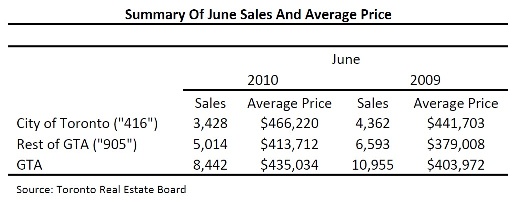
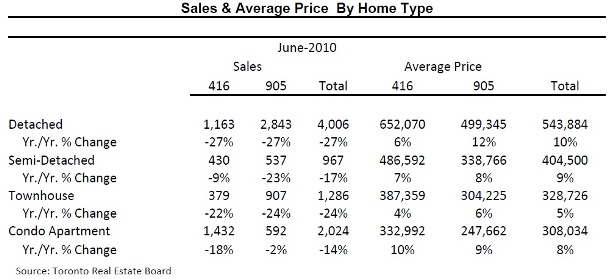

 Greater Toronto REALTORS® reported 4,139 sales through the Multiple Listing Service® (MLS®) during the first two weeks of June 2010. This represented a 20 per cent decrease compared to the 5,185 sales recorded during the same period in 2009. New listings increased by 21 per cent annually to 7,985.
Greater Toronto REALTORS® reported 4,139 sales through the Multiple Listing Service® (MLS®) during the first two weeks of June 2010. This represented a 20 per cent decrease compared to the 5,185 sales recorded during the same period in 2009. New listings increased by 21 per cent annually to 7,985.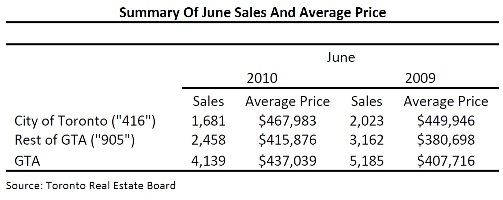
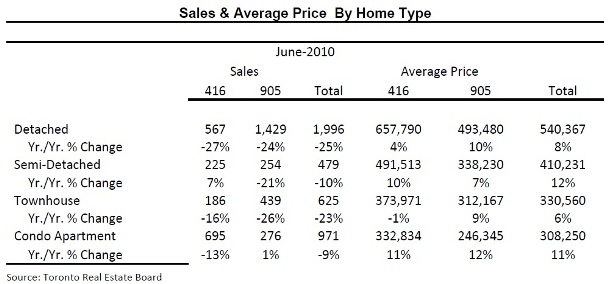
 Earlier this year I wrote a Blog post about the coming of
Earlier this year I wrote a Blog post about the coming of  I was recently speaking with a couple of friends who are thinking of selling their condo and moving into something bigger. "We're hearing that prices are cooling off - should we wait awhile before making a move?" Good question. Unfortunately, there isn't one catch-all answer.
I was recently speaking with a couple of friends who are thinking of selling their condo and moving into something bigger. "We're hearing that prices are cooling off - should we wait awhile before making a move?" Good question. Unfortunately, there isn't one catch-all answer.  Greater Toronto REALTORS® reported 9,470 sales through the Multiple Listing Service® (MLS®) in May, representing a one per cent dip from May 2009. In comparison to previous years, this was the third highest May sales result on record.
Greater Toronto REALTORS® reported 9,470 sales through the Multiple Listing Service® (MLS®) in May, representing a one per cent dip from May 2009. In comparison to previous years, this was the third highest May sales result on record.
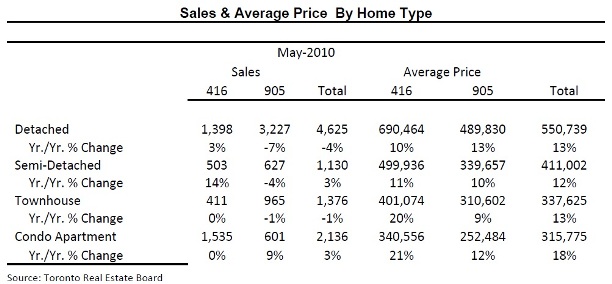
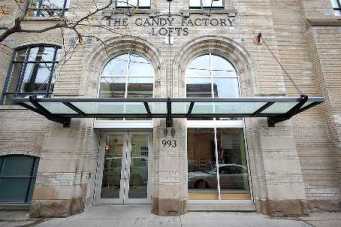 If you were to stop someone on the street in Toronto and ask them, "Can you name a residential loft building here in the city?" I bet the answer you'd hear most would be, "
If you were to stop someone on the street in Toronto and ask them, "Can you name a residential loft building here in the city?" I bet the answer you'd hear most would be, "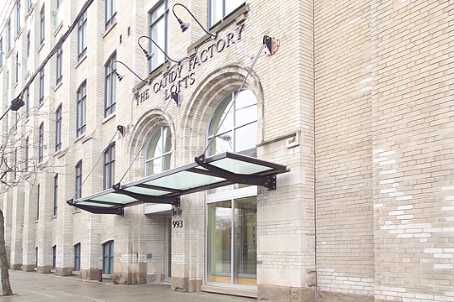
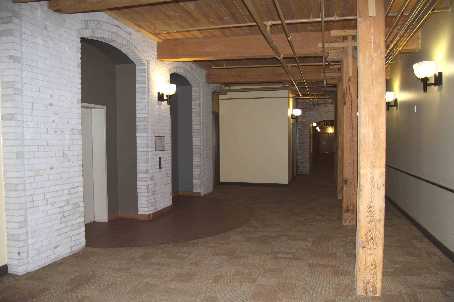
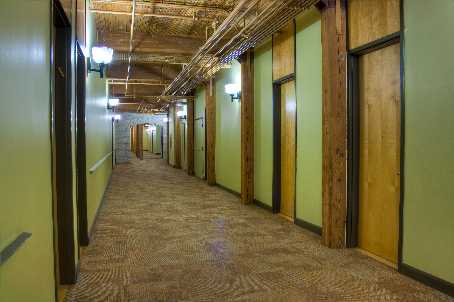

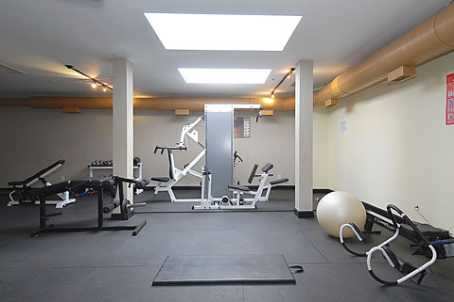
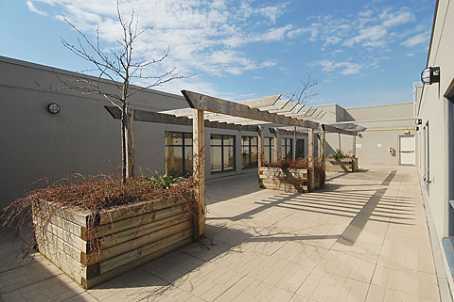
 Greater Toronto REALTORS® reported 4,887 sales through the Multiple Listing Service® (MLS®) during the first two weeks of May. This represented a seven per cent increase compared to the 4,561 sales recorded during the same period in 2009. New listings increased by 48 per cent annually to 10,059.
Greater Toronto REALTORS® reported 4,887 sales through the Multiple Listing Service® (MLS®) during the first two weeks of May. This represented a seven per cent increase compared to the 4,561 sales recorded during the same period in 2009. New listings increased by 48 per cent annually to 10,059.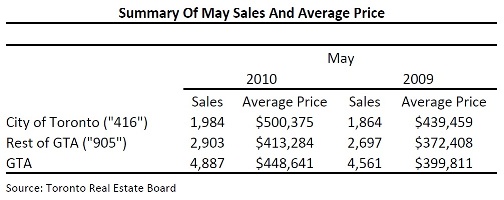
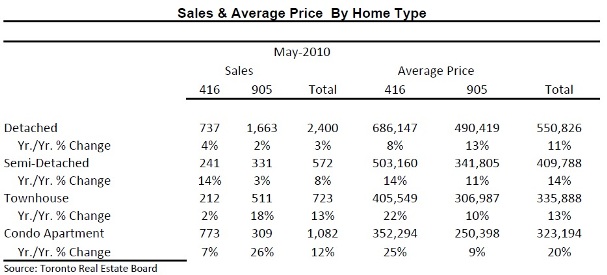
 Greater Toronto REALTORS® reported 10,898 sales through the Multiple Listing Service® (MLS®) in April, representing a 34 per cent increase compared to April 2009. There were also 20,683 new listings in April – a 59 per cent annual increase. Both the sales and new listings results amounted to new records for the month of April under the current Toronto Real Estate Board (TREB) boundaries.
Greater Toronto REALTORS® reported 10,898 sales through the Multiple Listing Service® (MLS®) in April, representing a 34 per cent increase compared to April 2009. There were also 20,683 new listings in April – a 59 per cent annual increase. Both the sales and new listings results amounted to new records for the month of April under the current Toronto Real Estate Board (TREB) boundaries.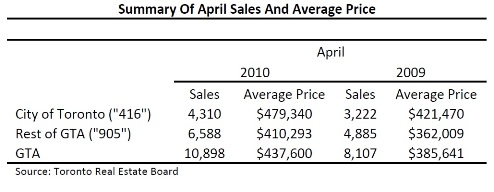
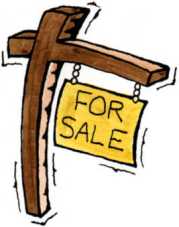 Greater Toronto REALTORS® reported 4,601 sales through the Multiple Listing Service® (MLS®) during the first two weeks of April. This represented a 25 per cent increase compared to the 3,681 sales recorded during the same period in 2009. New listings increased by 48 per cent annually to 9,512.
Greater Toronto REALTORS® reported 4,601 sales through the Multiple Listing Service® (MLS®) during the first two weeks of April. This represented a 25 per cent increase compared to the 3,681 sales recorded during the same period in 2009. New listings increased by 48 per cent annually to 9,512.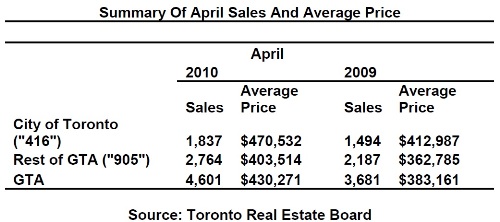
 Who likes a more balanced market? I do! I do! So far, this year's spring market has seen the arrival of more listings than we've had in awhile. Although we're still aways from being "balanced", Toronto's inventory shortage does seem to be easing up a bit.
Who likes a more balanced market? I do! I do! So far, this year's spring market has seen the arrival of more listings than we've had in awhile. Although we're still aways from being "balanced", Toronto's inventory shortage does seem to be easing up a bit. Greater Toronto REALTORS® reported 10,430 sales through the Multiple Listing Service® (MLS®) in March, pushing total first quarter 2010 sales to 22,418 – the best result on record under the current Toronto Real Estate Board (TREB) boundaries. The average price for March transactions was $434,696. The average price for the first quarter was $427,948.
Greater Toronto REALTORS® reported 10,430 sales through the Multiple Listing Service® (MLS®) in March, pushing total first quarter 2010 sales to 22,418 – the best result on record under the current Toronto Real Estate Board (TREB) boundaries. The average price for March transactions was $434,696. The average price for the first quarter was $427,948.
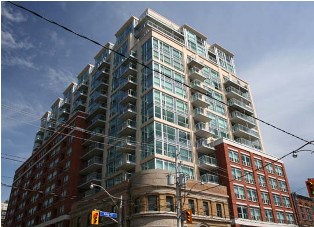 The
The 
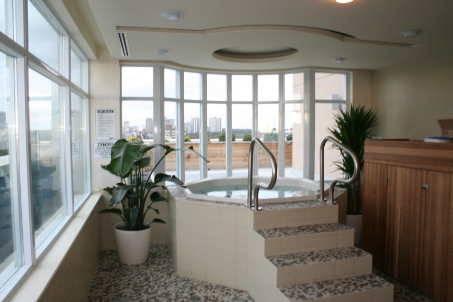
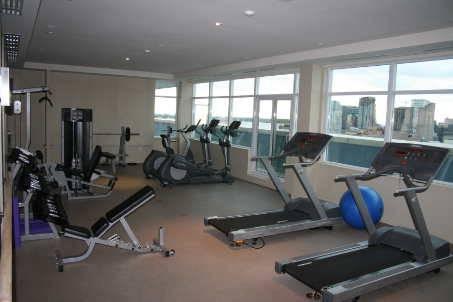
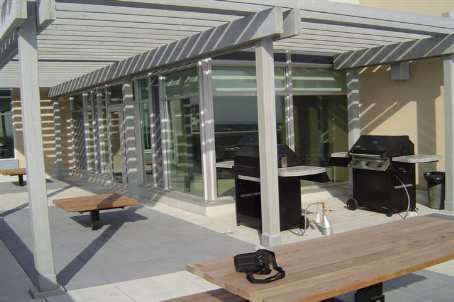
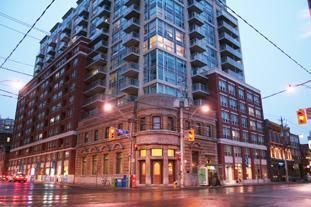

 The recent issues between the Canadian Real Estate Association and the Canadian Competition Bureau have sparked a handful of fruitful conversations between myself and friends, clients, etc, over the past few weeks. I've found myself more than once listing off the many ways a person benefits by using a realtor to buy or sell their home. Sitting near the top of this list is the detailed knowledge a realtor has of the market in both broad and specific terms.
The recent issues between the Canadian Real Estate Association and the Canadian Competition Bureau have sparked a handful of fruitful conversations between myself and friends, clients, etc, over the past few weeks. I've found myself more than once listing off the many ways a person benefits by using a realtor to buy or sell their home. Sitting near the top of this list is the detailed knowledge a realtor has of the market in both broad and specific terms. Greater Toronto REALTORS® reported 4,353 sales through the Multiple Listing Service® (MLS®) during the first two weeks of March. This represented a 70 per cent increase compared to the 2,562 sales recorded during the same period in 2009 when resale transactions had dipped markedly due to the recession. The mid-month sales total was also 16 per cent higher than the previous March midmonth high reached in 2006.
Greater Toronto REALTORS® reported 4,353 sales through the Multiple Listing Service® (MLS®) during the first two weeks of March. This represented a 70 per cent increase compared to the 2,562 sales recorded during the same period in 2009 when resale transactions had dipped markedly due to the recession. The mid-month sales total was also 16 per cent higher than the previous March midmonth high reached in 2006. 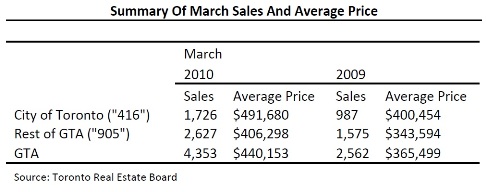
 Anyone familiar with that strip of
Anyone familiar with that strip of